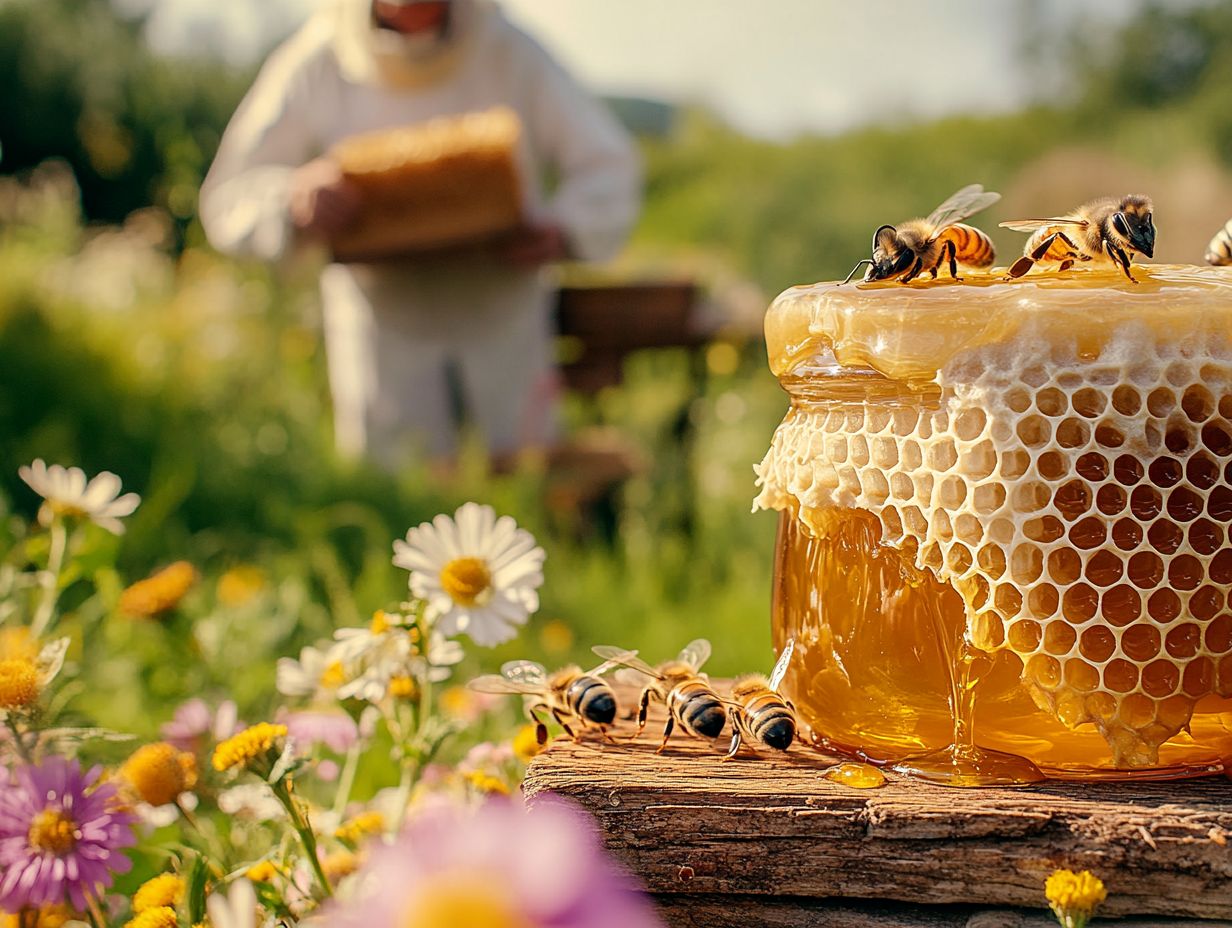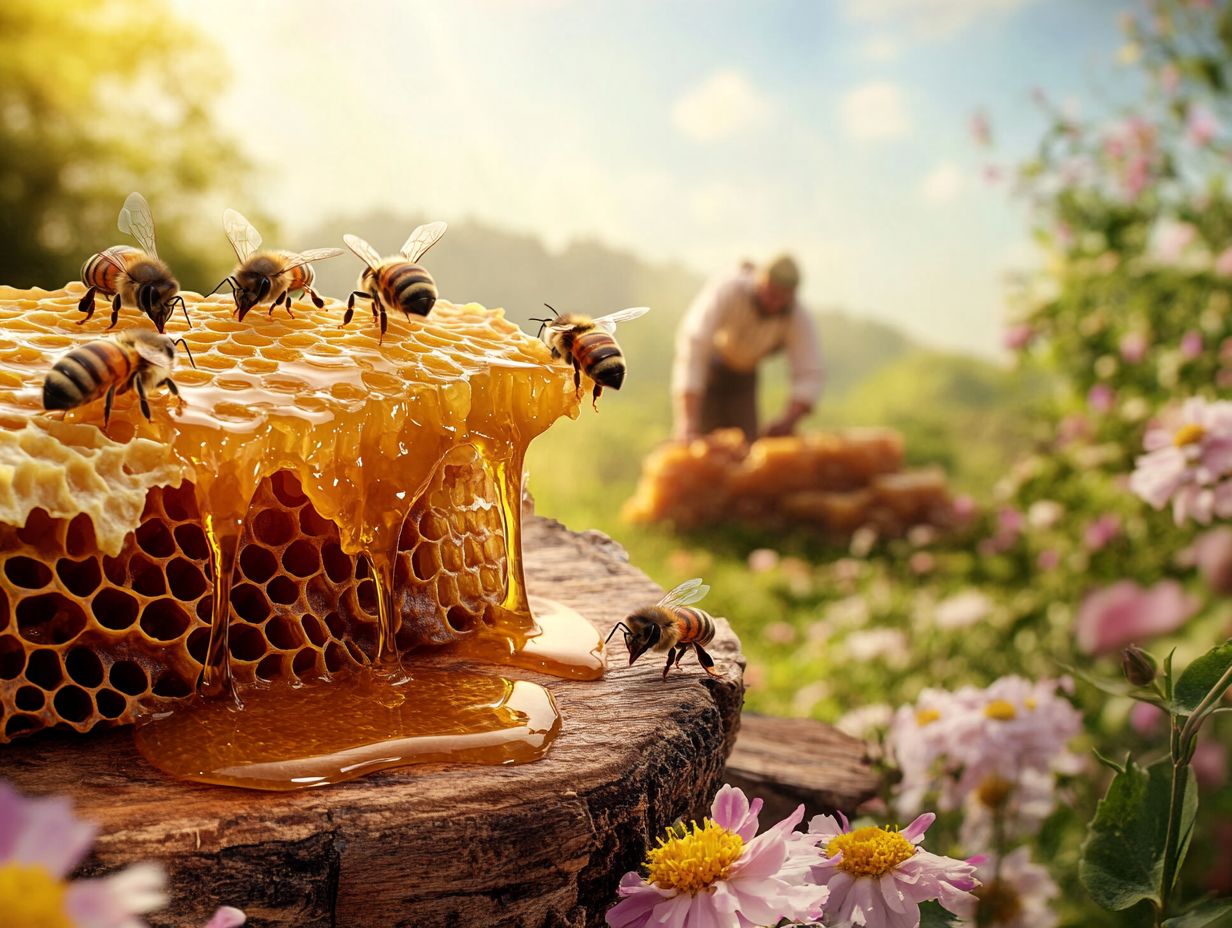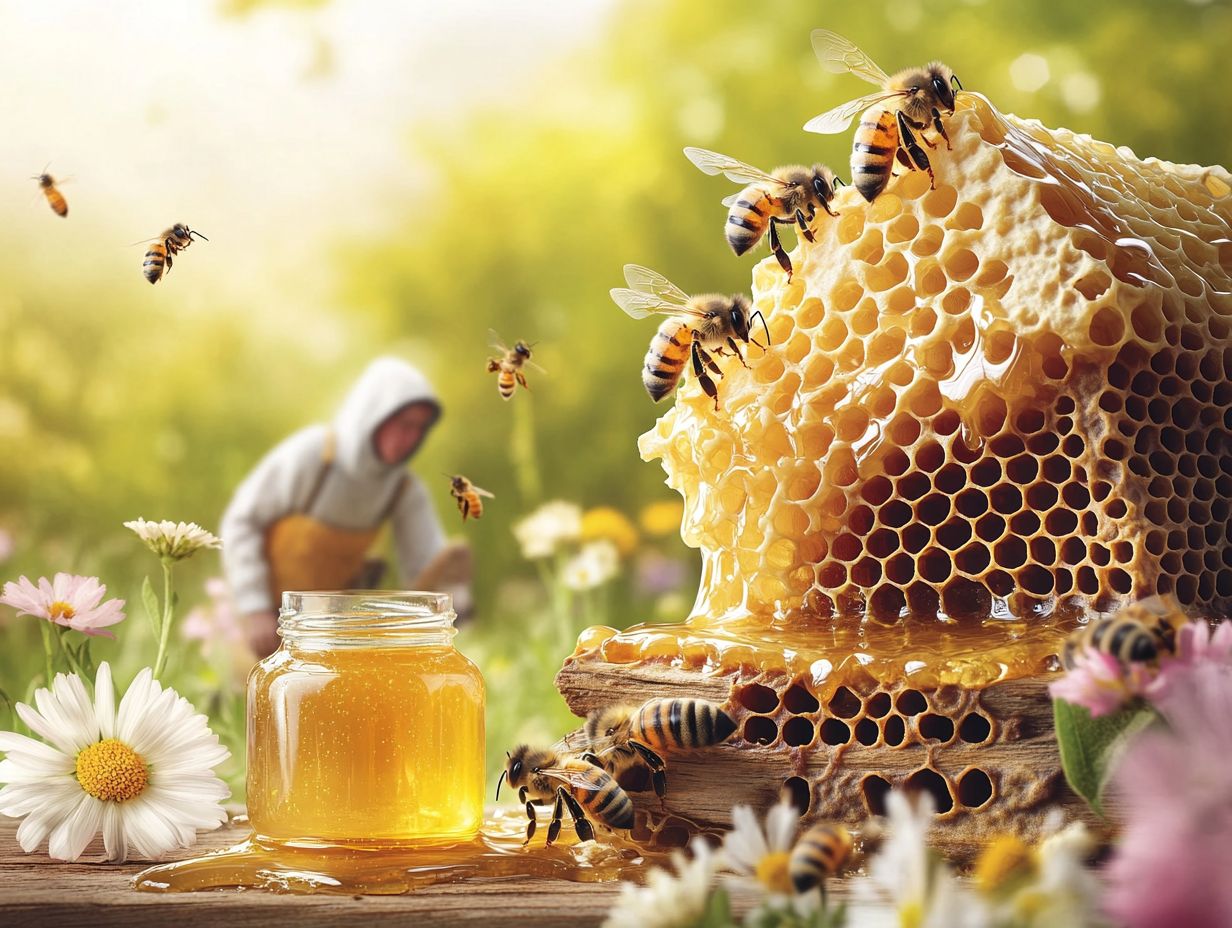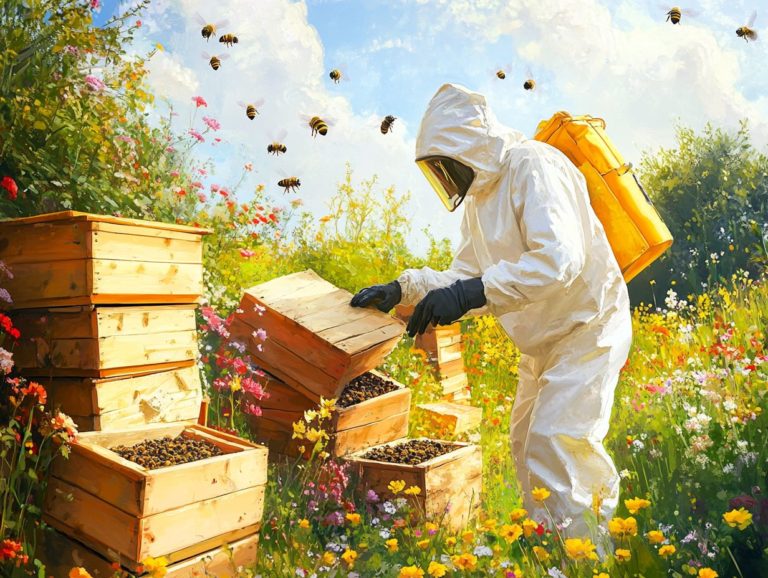The Economics of Honey Production
Honey, a timeless and cherished sweetener, has captivated humanity for centuries. Its production has evolved dramatically, shifting from ancient beekeeping practices to modern methods, mirroring both technological advancements and changing consumer preferences.
This article takes you on a journey through the rich history and diverse types of honey. You will explore the intricate production process while examining the economic landscape of the honey market. Discover the myriad benefits that honey offers!
It also delves into the challenges faced by honey producers today, including environmental threats and competition. Join us as we uncover the fascinating world of honey production and the intricate networks of local associations that support bee farmers and commercial beekeepers!
Contents
- Key Takeaways:
- The History of Honey Production
- The Process of Honey Production
- The Economics of Honey Production
- The Benefits of Honey Production
- The Challenges of Honey Production
- Frequently Asked Questions
- What is The Economics of Honey Production?
- What are the main costs involved in honey production?
- How is the revenue generated in honey production?
- What are the factors that affect the profitability of honey production?
- How does the price of honey affect the economics of honey production?
- Is honey production a sustainable business?
Key Takeaways:
- Honey production has a rich history and has evolved significantly, leading to various types of honey with distinct flavors and characteristics.
- The process of honey production involves harvesting, extracting, filtering, and bottling, requiring specialized equipment and skills.
- The economics of honey production are influenced by market demand, production costs, and profit margins, making it essential for commercial beekeepers to manage their operations carefully.
The History of Honey Production
The history of honey production stretches back thousands of years. Ancient civilizations like the Egyptians and Romans embraced beekeeping for its delightful nectar, economic advantages, and health benefits. Honey was not just a sweetener; it was revered by deities and woven into the fabric of various cultures.
Through ancient texts and artifacts, we see honey served as both a vital food source and a valuable trade commodity, highlighting its significance across different eras and regions.
How Has Honey Production Evolved Over Time?
Honey production has undergone a remarkable transformation. It has shifted from traditional beekeeping methods to modern commercial practices that enhance efficiency and yield on bee farms worldwide.
In the past, bee farmers used rudimentary techniques, like hollow tree trunks or basic wooden boxes, to harvest honey, often lacking a thorough understanding of bee behavior and hive health. Today, advanced equipment, such as flow hives and automated extractors, streamline extraction and improve hive management.
Now, beekeepers can easily monitor colony health with digital sensors and mobile applications. As a result, today’s beekeepers produce honey more sustainably, optimizing yield while addressing challenges posed by environmental changes.
What Are the Different Types of Honey Produced?
The landscape of honey production presents an array of types, including the renowned Manuka and the increasingly popular Eucalyptus honey, each boasting distinct flavors and nutritional properties tailored for discerning consumers.
These unique varieties often reflect the geographical nuances of their locales—from the rich, aromatic wildflower honey of the American Midwest to the rare and highly coveted Tupelo honey from Florida. People increasingly appreciate honey that is not just delicious but also pure and authentic.
Quality is paramount, as consumers seek out honey that is raw and unfiltered, ensuring its natural benefits remain intact and reflecting a commitment to sustainability and ethical production practices. Bee farmers play a crucial role in this intricate process, dedicating their craft to cultivating specific types of honey while implementing sustainable practices that protect both the bees and the environment.
The Process of Honey Production
The journey of honey production involves several essential steps. It begins with meticulous hive management and culminates in the careful extraction and bottling of the honey.
This process ensures that the sweet nectar is harvested and processed effectively, preserving its quality and exquisite flavor throughout.
1. Harvesting Honey from Beehives
Harvesting honey from colonies demands a careful method to ensure that bee colonies experience minimal disturbance while you maximize your honey extraction.
The best time to harvest honey is during the warmest part of the day when bees are calmer. To facilitate this, you might employ various tools, such as smokers, which create a gentle haze that helps pacify the bees, reducing their defensiveness.
Seasonal factors also play a significant role; the availability of flowering plants can greatly influence honey yield. An abundance of blooms translates to increased nectar flow. Prioritizing the health of your bee colonies is essential; strong, well-cared-for hives tend to be more productive and resilient during the harvesting process, ensuring the sustainability of your beekeeping endeavors for years to come.
2. Extracting Honey from Honeycombs
The extraction of honey from honeycombs is a careful process that requires your careful attention. It involves removing frames from the hives and utilizing specialized equipment to separate the honey from the wax comb.
Start by carefully removing the frames from the hive, ensuring minimal disturbance to the bees and their environment. You would typically use an extractor, a machine that spins the frames to get the honey out while preserving the wax structure.
Maintaining the integrity of both the frames and the foundation is crucial; it allows the bees to reuse the wax for future honey production, enhancing their overall health and productivity.
As you consider the bees’ well-being, take particular care with the use of miticides to prevent pests, such as small groups of bees used for breeding, ensuring that any chemicals used do not compromise the quality of the honey. Adopting a respectful approach to extraction honors the vital role of bees in the ecosystem.
3. Filtering and Bottling Honey
Filtering and bottling honey are crucial final steps in the honey production process, designed to ensure that your final product is pristine and ready for consumers.
Act quickly to filter the honey, using various filtering methods, such as fine mesh screens and heat treatment, which effectively capture wax particles, pollen, and other natural debris. This meticulous approach not only enhances the clarity of the honey but also preserves its delicate flavors, allowing the true essence of the honey to shine through.
Once filtering is finished, the honey is carefully transferred into sterilized bottles. Quality control is vital in the bottling process; it ensures your honey meets high standards for purity and consistency.
It’s essential to recognize that honey processing significantly impacts its taste and nutritional value. Adding granulated sugar in certain products can compromise the natural flavor profile and diminish health benefits. Therefore, maintaining traditional methods while prioritizing quality is key to delivering a product that consumers can trust and genuinely enjoy.
The Economics of Honey Production
The economics of honey production involves a sophisticated interplay of various factors that shape profit margins, market dynamics, and the strategic approaches you employ as a commercial beekeeper. By understanding these elements, you can effectively optimize honey yield while minimizing expenses, enhancing the overall profitability of your operations.
What Is the Market Demand for Honey?
The market demand for honey has grown significantly as values shift towards natural and organic products. Honey has become a highly sought-after commodity across various markets, especially in the UK and France.
This change is mainly driven by an increasing awareness of the health benefits of honey, including its antioxidant properties and its reputation as a natural energy source. This aligns with the goals of local associations that promote honey consumption.
Organic certifications are essential for many buyers, fostering a preference for ethically sourced and sustainably produced options.
Local associations play a vital role in educating consumers about the nutritional value and versatility of honey in diets. For honey producers, understanding these trends is critical. They can adopt strategies such as diversifying their product range, emphasizing local and organic practices, and enhancing their marketing efforts to resonate with consumer preferences.
What Factors Affect the Price of Honey?
Several factors influence the pricing of honey, including production costs, market dynamics, and the influence of local associations that set quality standards.
The balance of supply and demand significantly impacts prices. A shortage or a surge in production can cause prices to soar or drop. The extraction methods used—whether handcrafted or mass-produced—also affect costs and shape consumer perceptions.
Competition from imported honey often forces local producers to rethink their pricing strategies, especially when lower-priced imports flood the market. Local associations uphold stringent quality standards, ensuring consumers receive superior products while advocating for fair pricing.
What Are the Costs of Honey Production?
The costs of honey production can vary widely, covering a range of expenses from equipment and hive management to the maintenance of bee colonies.
Expenses typically fall into two categories: fixed and variable costs. Fixed costs include beekeeping equipment and hive boxes. These remain constant regardless of production levels. In contrast, variable costs fluctuate and include feed, transportation, and medications for bee health.
Effective cost management can enhance profitability. This involves tracking expenses and finding ways to streamline operations. Innovative strategies, like bulk purchasing supplies and utilizing technology to monitor hive health, help reduce costs and create a more sustainable beekeeping business.
What Are the Profit Margins for Honey Producers?
Profit margins for honey producers are influenced by various economic factors, including production costs, market demand, and the pricing strategies used by producers.
Understanding these factors lets honey producers optimize production processes and improve profitability. For example, using efficient extraction and bottling methods can lower operational costs.
Diversifying product offerings, such as flavored honeys or beeswax products, helps capture a broader market share. Successful apiaries focus on strategic branding to attract health-conscious consumers.
Positioning products within niche markets, like artisanal or gourmet segments, allows producers to charge higher prices, leading to better financial outcomes.
The Benefits of Honey Production
Engaging in honey production offers many advantages, from economic benefits for producers to significant environmental contributions. These contributions bolster bee health and promote ecosystem sustainability.
Now is the time to explore honey production!
1. Economic Benefits for Beekeepers
The economic benefits for you as a beekeeper in honey production are rich and varied. This venture often leads to significant profits and a sustainable livelihood.
You can diversify your income by selling products like beeswax, propolis, and pollen. It also creates jobs within your local community.
High-quality honey production attracts gourmet markets, where artisanal honey can command premium prices. Focusing on niche markets, such as organic honey, can lead to remarkable growth.
2. Environmental Benefits for Bees and Ecosystems
The environmental benefits of honey production are important for supporting bee populations and promoting sustainability.
By practicing sustainable beekeeping, you produce better honey and create incentives to preserve natural habitats essential for bees. This includes planting diverse floral crops to enhance pollination.
Education is key. Many initiatives help beekeepers understand the importance of environmental stewardship, leading to practices that boost biodiversity.
Collaborative programs among beekeepers, conservationists, and communities strengthen the ties between honey production and ecological health.
3. Health Benefits of Consuming Honey
Discover the amazing health benefits of honey! It’s a great choice for those who prioritize natural and nutritious foods.
Rich in antioxidants, honey supports overall well-being and acts as a natural remedy for many ailments. Its antimicrobial properties can aid in wound healing and boost your immunity.
Recent research suggests honey can improve gut health and enhance athletic performance. This trend reflects a broader movement toward sustainability and transparency.
The Challenges of Honey Production
Honey production faces many challenges that impact the quality and quantity of honey available. You must consider threats to bee populations, imported honey competition, and industry regulations.
Each of these factors shapes honey production and availability.
1. Threats to Bee Populations
Threats like the Varroa mite pose significant challenges to honey production and the health of our ecosystems.
This tiny parasite weakens bees and makes them vulnerable to diseases. Environmental changes, such as climate change and habitat loss, disrupt their foraging patterns.
The widespread use of certain pesticides worsens the situation. These chemicals can be harmful to bee populations.
To tackle these threats, embracing sustainable beekeeping practices is essential. Prioritize organic farming and restore habitats to create a healthier environment for bees.
2. Competition from Imported Honey
Competition from imported honey poses significant challenges for you as a local honey producer. You find yourself navigating price variations and quality perceptions in an increasingly globalized market.
In this landscape, it can be tough to showcase the unique qualities of your honey when cheaper alternatives flood the shelves. The arrival of foreign honey impacts your pricing strategies and raises doubts about quality and purity. This leads consumers to question the sources of their sweeteners.
As a local beekeeper, you face the crucial task of educating the public on the numerous benefits of locally-sourced honey. These benefits include supporting local economies and promoting biodiversity. To thrive in this competitive arena, consider adopting innovative marketing strategies, highlighting sustainable practices, and enhancing your packaging to attract health-conscious consumers.
3. Regulations for Honey Production and Labeling
Regulations surrounding honey production and labeling are essential for safeguarding consumer safety and upholding the integrity of the honey industry.
These regulations define what qualifies as pure honey, meaning honey with no added ingredients. They also establish clear labeling requirements that consumers can rely on for accurate information. For example, honey products must be properly labeled with their origin and must clearly indicate if they contain any additives or sweeteners.
Safety standards are strictly enforced to prevent contamination and ensure that the honey you purchase is free from harmful substances.
Local associations play an important role in this framework by promoting compliance with regulations, providing valuable resources for producers, and championing consumer interests. Their efforts foster trust in honey products and support sustainable practices within the industry. You can enjoy your honey with confidence!
Frequently Asked Questions
What is The Economics of Honey Production?
The Economics of Honey Production refers to the analysis and study of the financial aspects of producing honey. This includes the costs involved, revenue generated, and profitability of the honey production process, as well as the average yield of honey per apiary.
What are the main costs involved in honey production?
The main costs involved in honey production include beekeeping equipment, labor, bee colonies, and production supplies such as hives, frames, and foundation. Other costs may include transportation, marketing, and storage expenses related to honey production in the UK and France.
How is the revenue generated in honey production?
The revenue in honey production is primarily generated through the sale of honey and other honeybee products such as beeswax, pollen, and royal jelly. Some beekeepers may also earn income from pollination services or offering beekeeping classes, particularly through organizations such as the Bee Farmers Association and the BBKA.
What are the factors that affect the profitability of honey production?
Several factors can influence the profitability of honey production. These include the cost of production, market demand for honey and honeybee products, and weather conditions. Additionally, pests like Varroa, a harmful mite that can affect bee health, significantly impact the health and productivity of bee colonies. Government regulations and policies may also impact profitability.
How does the price of honey affect the economics of honey production?
The price of honey significantly impacts the economics of honey production. When the price of honey is high, especially for premium products like Manuka, it can increase the profitability of beekeeping. However, when prices are low, it can lead to financial challenges for beekeepers as they may struggle to cover their production costs.
Is honey production a sustainable business?
Yes, honey production can be a sustainable business when managed properly. Sustainable practices in beekeeping include using natural methods to control pests and diseases, such as the strategic use of granulated sugar to combat Varroa, promoting biodiversity, and ensuring the health and welfare of bee colonies, including those producing mad honey in regions like Egypt and Rome. These practices can lead to long-term profitability and environmental conservation.
Explore how local honey supports your community!





